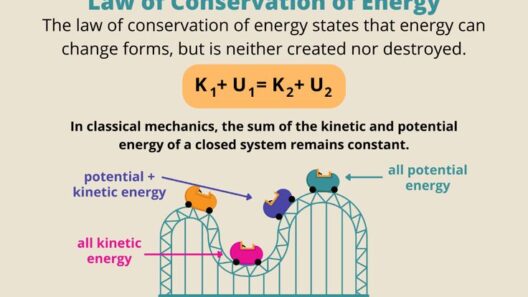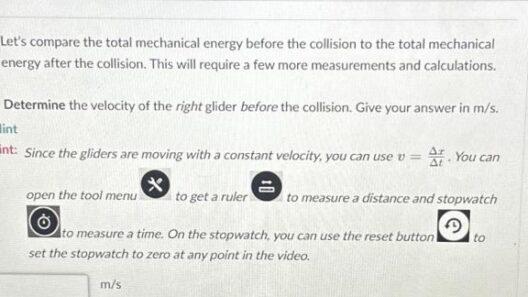In the realm of physics, the concept of conservation is paramount, particularly when examining mechanical energy. Mechanical energy, which constitutes the sum of potential and kinetic energy within a system, often adheres to the principle of conservation under ideal circumstances. This principle is foundational in understanding the balance of forces and motions that govern various natural phenomena.
The first type of mechanical energy we consider is kinetic energy, which is the energy possessed by an object in motion. Expressed mathematically as KE = 1/2 mv², where m represents mass and v denotes velocity, kinetic energy is directly proportional to the square of the velocity. This means that even minimal increases in speed can result in substantial increases in kinetic energy. Understanding this relationship is critical, especially in the context of climate change, where efficient energy usage is vital.
On the other hand, potential energy is the stored energy in an object due to its position or configuration. The most straightforward example is gravitational potential energy, given by PE = mgh, with g representing the acceleration due to gravity, and h the height above a reference point. In various natural systems, potential energy transforms into kinetic energy and vice versa, exemplifying the symbiosis of these two forms of energy.
Consider a roller coaster as an illustrative example of mechanical energy conservation. At the zenith of its track, the coaster possesses maximum potential energy due to its height. As it descends, this potential energy is converted into kinetic energy, culminating in exhilarating speeds at the lowest points. Understanding the dynamics of this energy conversion illustrates critical concepts in energy conservation laws.
The principle of conservation of mechanical energy posits that in the absence of non-conservative forces—like friction or air resistance—the total mechanical energy of a system remains constant. This leads to scenarios where energy is transformed rather than lost. In ideal systems, where friction is negligible, mechanical energy conservation enables predictions about motion and behavior, serving as a fundamental tenant of classical mechanics.
However, real-world scenarios often involve various forces that impede this ideal balance. Friction, for instance, dissipates energy as heat, representing a paragon of a non-conservative force. While systems like roller coasters aim for maximal efficiency and minimal energy loss, frictional forces can mitigate this, necessitating the consideration of energy losses in practical applications.
Furthermore, energy conservation extends beyond mere motion within confined environments. In the context of machinery and engineering, understanding mechanical energy conservation allows for the design of more efficient systems. For example, regenerative braking systems in electric vehicles capture kinetic energy during braking and convert it back into stored energy, emphasizing the pragmatic application of conservation laws.
Atmospheric systems also exemplify mechanical energy principles. The kinetic energy in wind, which arises from the uneven heating of the Earth’s surface by solar radiation, can be harnessed through wind turbines. Thus, by tapping into this kinetic energy, we can generate electricity, illustrating both the conservation of energy principle and its practical application in addressing contemporary energy challenges.
Another salient aspect is resonant systems, such as pendulums or springs. These systems exhibit periodic motion, wherein potential energy and kinetic energy oscillate between forms, yet the total mechanical energy remains conserved throughout the cycle. This oscillatory behavior can be harnessed and utilized in various technological applications, including clocks and seismic isolation systems.
The conservation of mechanical energy principle not only underlies physical interactions but also ties into broader ecological considerations. The balance of energy helps explain the energy flow within ecosystems. For example, plants convert solar energy into chemical energy through photosynthesis. This energy is then transferred through various trophic levels, from herbivores to apex predators. Understanding energy dynamics in ecological systems highlights the interconnectedness of living organisms and their environment.
In summary, the conservation of mechanical energy serves as a cornerstone in the study of physics, allowing for a comprehensive understanding of motion, forces, and energy transformations. From roller coasters to energy-efficient technologies and ecological systems, the principles governing energy conservation reveal the elegant balance present in nature. This balance not only underscores fundamental scientific concepts but also provides contextual frameworks for addressing modern challenges, including climate change. As we advocate for sustainability and environmental stewardship, the efficient use of energy—and the understanding of its conservation—becomes paramount.
By embracing these principles, we can design new technologies and practices that minimize energy waste, thereby contributing towards a more sustainable future. In this endeavor, recognizing the constant interplay of potential and kinetic energy can foster innovative solutions that align with ecological preservation and responsible resource management.








